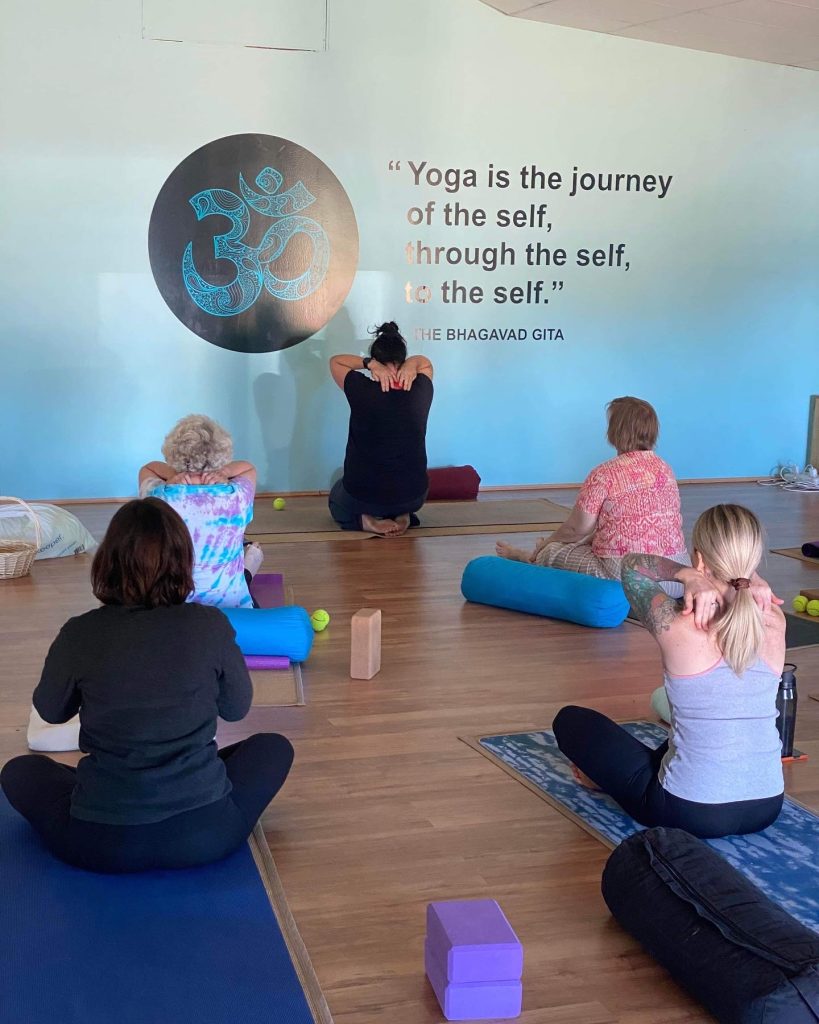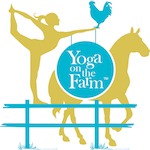Types of Yoga at Yoga on the Farm
We have a variety of yoga styles here at Yoga on the Farm. What’s the right style for you? No one will ever be able to know what is right for your body.
We have a great Intro Class Pass which allows you 30 days to try 5 classes ( buy it here ) Feel free to contact us if you still need help with choosing your class.
- Just starting out? Try a Beginners or Hatha foundations class
- Myo yin and Yin yoga are slow style and suitable for most people.
- Chair yoga is great for learning yoga for when you have injuries or if you spend all day in a chair.

Hatha Yoga
Flexibility, balance, relaxation, mindful practice
Hatha yoga, rooted in ancient Indian tradition, embodies the balance of opposing forces, symbolized by the sun (ha) and the moon (tha). This style encompasses a series of physical postures (asanas) aimed at aligning muscles and bones, enhancing flexibility, and fostering overall physical health. With a deliberate focus on breath control (pranayama), practitioners engage in techniques like deep breathing and alternate nostril breathing to promote relaxation, concentration, and the free flow of energy throughout the body.
Emphasizing a gentle and mindful approach, Hatha yoga classes typically proceed at a slower pace compared to more vigorous styles. Here, practitioners are encouraged to cultivate awareness, maintaining proper alignment and gently stretching muscles while incorporating meditation and relaxation techniques to calm the mind and alleviate stress. Suitable for all levels, instructors offer variations and modifications to accommodate diverse abilities and body types, making Hatha yoga accessible to a wide range of individuals seeking physical and mental well-being through its harmonizing blend of physical postures, breathwork, and meditation practices
Vinyasa
Strength, flexibility, fitness, rhythmic flow
Vinyasa yoga is a dynamic and flowing style of yoga that synchronizes breath with movement, creating a seamless transition between poses. In Vinyasa practice, each movement is linked with either an inhalation or an exhalation, fostering a continuous and rhythmic flow. This style often incorporates a series of Sun Salutations (Surya Namaskar) as a foundational sequence, which serves to build heat and energy in the body while promoting flexibility and strength. Vinyasa classes can vary in intensity and pace, ranging from gentle and meditative to vigorous and challenging, making it accessible to practitioners of all levels.
One of the defining characteristics of Vinyasa yoga is its emphasis on creative sequencing, allowing instructors the freedom to craft unique and varied sequences tailored to the needs and preferences of their students. This style encourages practitioners to move with intention and mindfulness, cultivating a deeper connection between mind, body, and breath. Through consistent practice, Vinyasa yoga not only enhances physical fitness but also promotes mental clarity, stress relief, and overall well-being, making it a popular choice for those seeking a balanced and holistic approach to health and fitness.
Yin Yoga
Gentle, meditative, deep stretch, flexibility, mobility, relaxation
Yin yoga is a gentle and meditative style of yoga that targets the deeper connective tissues of the body, such as ligaments, tendons, and fascia. Unlike more dynamic forms of yoga, Yin yoga involves holding passive poses for an extended period, typically ranging from one to five minutes or more. These longer holds allow practitioners to access deeper layers of tension and release, promoting flexibility, mobility, and relaxation. The practice is often characterized by its emphasis on stillness and surrender, encouraging practitioners to soften into each posture and observe sensations without judgment or resistance.
In Yin yoga, poses are typically performed close to the ground, with the support of props such as blocks, bolsters, and blankets to ensure comfort and stability. The focus is on finding a balance between effort and ease, allowing gravity to gently deepen the stretch over time. Through consistent practice, Yin yoga not only increases physical flexibility but also cultivates a sense of inner calm and introspection. It provides an opportunity for practitioners to slow down, tune into their breath, and cultivate mindfulness, making it a valuable complement to more active styles of yoga and a powerful tool for stress reduction and self-discovery.
MyoYin
Myofascial release + Yin Yoga, release tension, relaxation
MyoYin is a unique fusion of two complementary practices: Myofascial Release (Myo) and Yin yoga. Developed by Jo Phee and Joe Barnett, MyoYin combines the therapeutic benefits of Myofascial Release techniques with the meditative qualities of Yin yoga. Myofascial Release involves applying sustained pressure to specific points on the body to release tension and adhesions within the fascia, the connective tissue that surrounds and supports muscles and organs. By targeting the fascia, MyoYin aims to improve flexibility, mobility, and overall well-being.
In a MyoYin practice, practitioners engage in a series of Yin yoga poses with the added dimension of self-applied myofascial release techniques. This integration allows for a deeper release of tension within the body, as the combination of passive stretching and targeted pressure work synergistically to release tightness and promote relaxation. MyoYin sessions often incorporate the use of props such as foam rollers, massage balls, and therapy bands to facilitate self-massage and enhance the therapeutic effects of the practice. Through consistent practice, MyoYin can help alleviate chronic pain, improve posture, and enhance overall physical and mental resilience, offering practitioners a holistic approach to health and wellness.
Vin to Yin
invigoration movement to stillness
Vin to Yin is a yoga class format that seamlessly blends the dynamic movement of Vinyasa yoga with the introspective stillness of Yin yoga. This innovative fusion class begins with an invigorating Vinyasa flow sequence, characterized by continuous movement linked with breath. Vinyasa practice builds heat, strength, and flexibility in the body through a dynamic series of poses that flow smoothly from one to the next. The energetic nature of Vinyasa yoga helps to warm up the muscles, increase circulation, and prepare the body for deeper stretching and relaxation.
Following the dynamic Vinyasa portion, the class transitions into the slower-paced practice of Yin yoga. In Yin yoga, passive poses are held for an extended duration, typically ranging from one to five minutes or more, allowing for deep stretching of the connective tissues and joints. This phase of the class focuses on surrendering into each pose, releasing muscular tension, and cultivating a sense of inner calm and introspection. By combining the energizing movement of Vinyasa with the meditative qualities of Yin, Vin to Yin offers practitioners a balanced and holistic yoga experience that nourishes both body and mind.
Restorative Yoga
Gentle & therapeutic, deep rest, emotional relaxation
Restorative yoga is a gentle and therapeutic style of yoga that focuses on relaxation and deep rest. It typically involves holding a series of passive poses for extended periods, often supported by props such as bolsters, blankets, and blocks, to facilitate ease and comfort. The aim of restorative yoga is to promote physical, mental, and emotional relaxation, allowing the body to release tension and stress accumulated from daily life or other physical activities. By encouraging the body to relax deeply, restorative yoga activates the parasympathetic nervous system, triggering the body’s natural relaxation response and promoting a sense of calm and well-being.
In a restorative yoga class, poses are usually held for several minutes, allowing practitioners to surrender fully into each posture and let go of muscular effort. The focus is on deepening the breath, softening the body, and quieting the mind. Restorative yoga is especially beneficial for individuals dealing with chronic stress, fatigue, or recovering from injury or illness, as it provides an opportunity for rest and rejuvenation. Through regular practice, restorative yoga can help improve sleep quality, reduce anxiety, and enhance overall resilience, offering a gentle and nurturing approach to self-care and healing.
Chair Yoga
Gentle yoga in a chair. Ideal for limited mobility and desk workers
Chair yoga is a gentle form of yoga that adapts traditional yoga poses and practices to be performed while seated on a chair or using a chair for support. It is particularly well-suited for individuals with limited mobility, seniors, or those recovering from injuries, as it provides a safe and accessible way to experience the benefits of yoga. In chair yoga, practitioners perform a variety of modified poses, including stretches, twists, and gentle movements, designed to increase flexibility, improve posture, and promote relaxation. The use of a chair provides stability and support, making it easier for individuals with physical limitations to participate in yoga practice comfortably.
Chair yoga classes typically incorporate breathing exercises, mindfulness techniques, and relaxation practices to enhance overall well-being. These classes are often conducted in a seated position, but may also include standing poses or movements with the support of the chair for balance. Chair yoga can be practiced in a variety of settings, including senior centers, workplaces, and community centers, making it accessible to a wide range of individuals regardless of age or physical ability. With its gentle approach and emphasis on accessibility, chair yoga offers a valuable opportunity for individuals to improve their physical and mental health while seated comfortably.

